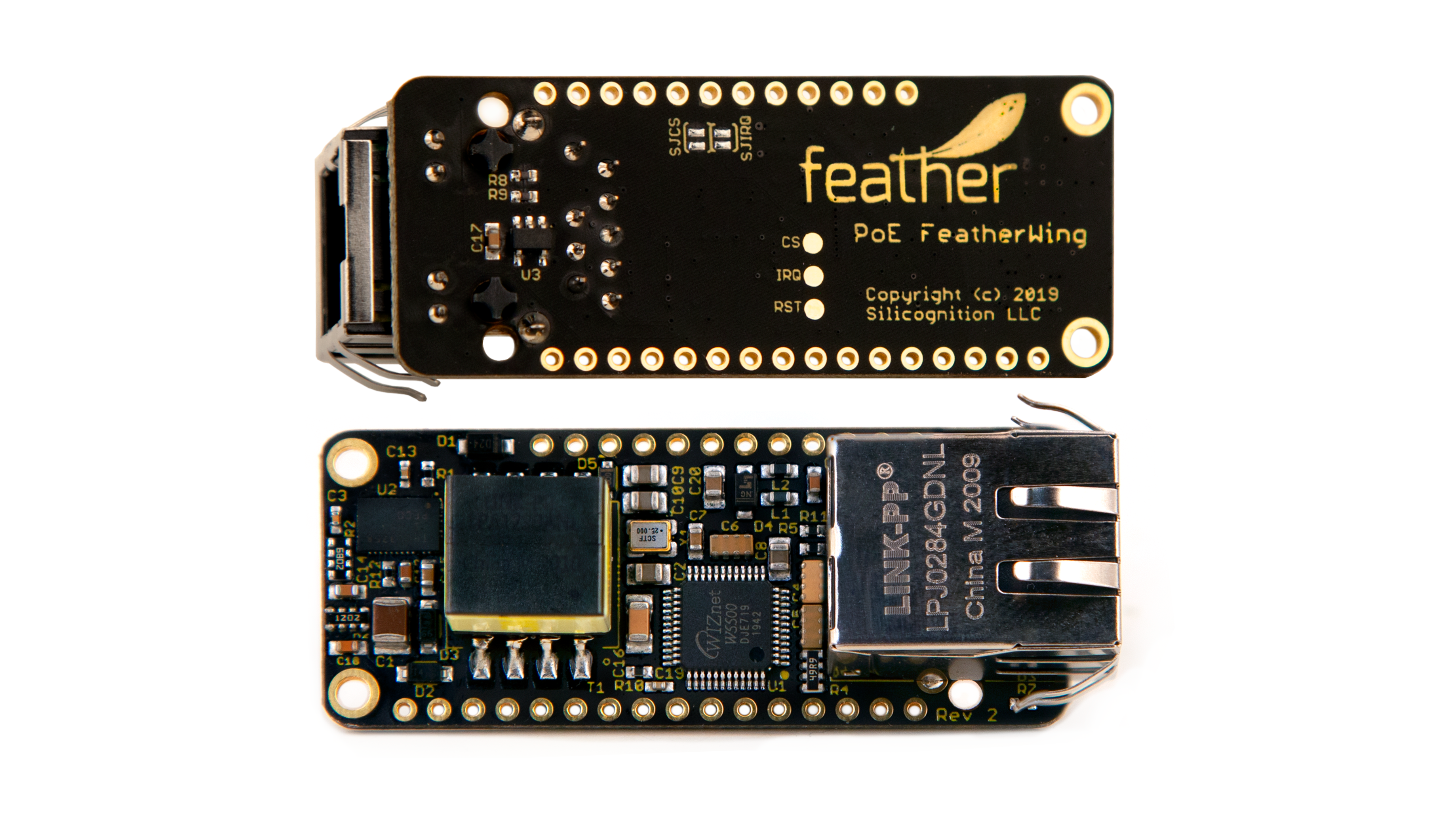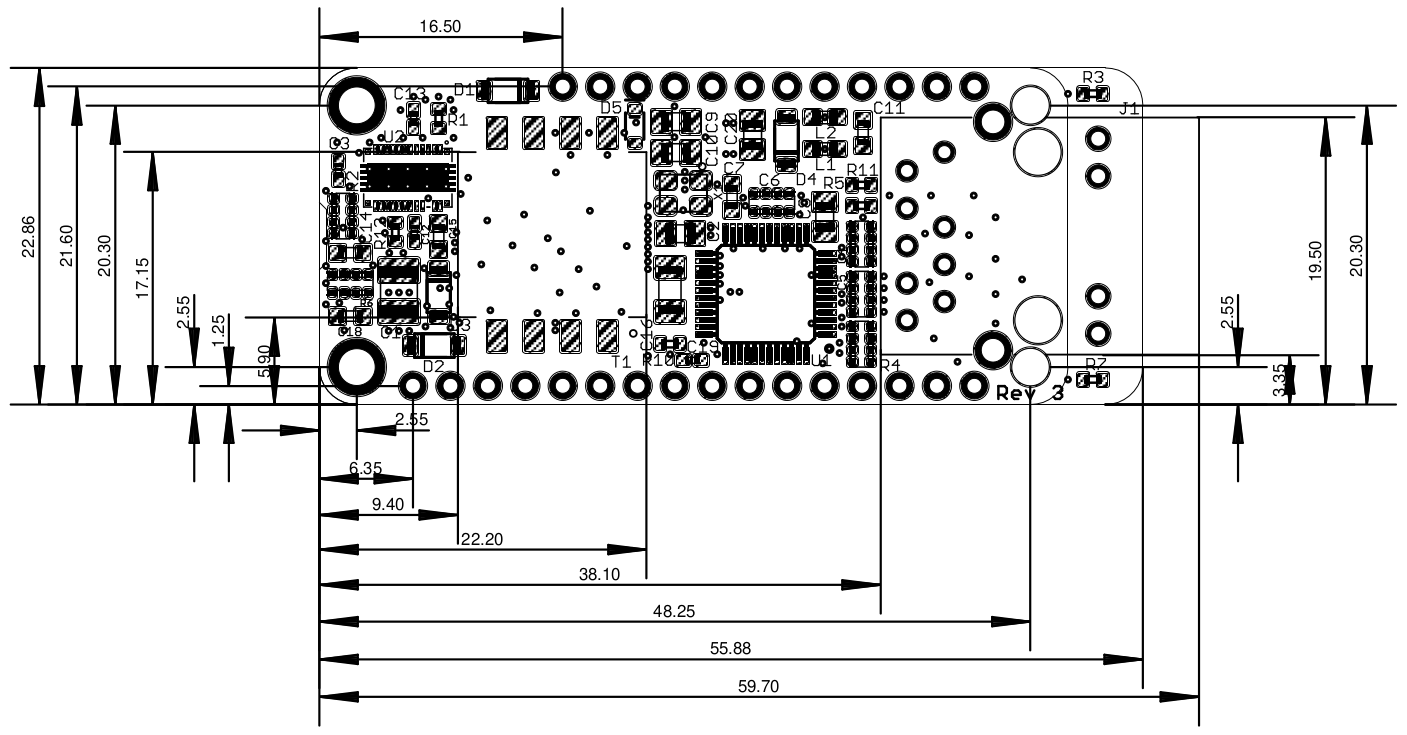PoE-FeatherWing¶
Where the Adafruit Ethernet FeatherWing just provides an Ethernet connection for Feather compatible boards, the PoE-FeatherWing provides Ethernet, fully isolated IEEE 802.3at/af compatibe PoE and a built-in MAC address in the same footprint.
Especially when used in combination with an RP2040-Shim, this allows for the creation of extremely compact Power over Ethernet systems.

Like the LiFePO4wered/Pi+ and the wESP32, the PoE-FeatherWing was successfully launched with a CrowdSupply campaign.
Features¶
- PoE: Isolated IEEE 802.3at Class 1, Mode A and Mode B Power over Ethernet, with 4 W of output power available
- Globally unique MAC address: A Microchip 24AA02E48 provides a built-in globally unique MAC address, allowing actual field deployment without having to change and recompile code for each device.
- Works with existing software: A WIZnet W5500 Ethernet controller ensures full compatibility with existing software written for the Adafruit Ethernet FeatherWing.
- Arduino driver: Works with the standard Arduino Ethernet driver
- MicroPython driver: Works with the standard MicroPython WIZNET5K driver
- CircuitPython driver: Works with the standard CircuitPython WIZNET5K driver
- Drop-in replacement: With board size and connections identical to the Adafruit Ethernet FeatherWing, it's a true drop-in replacement
- IRQ capability: A solder jumper allows for easy compatibility with boards or software that require the IRQ signal without needing to add a fly wire.
Simple Ethernet + Power for your Feather projects!¶
Arduino and CircuitPython example code is available on GitHub. This code includes examples like Arduino "Web Client Repeating", which allows you to make repeated HTTP requests using DNS, as well as others.
Solder jumpers¶
The bottom of the board has two solder jumpers and three solder pads.
Solder Jumpers:
| Jumper | Notes |
|---|---|
| SJCS | Solder Jumper Chip Select This solder jumper connects the W5500 Chip Select to the default pin IO10 (pin 22) of the Feather. This solder jumper is connected by default, there is a tiny trace between the pads that needs to be cut if the user wants to use another pin as Chip Select. To reconnect, it can be bridged with solder. |
| SJIRQ | Solder Jumper Interrupt Request This solder jumper can be used to connect the W5500 IRQ to IO12 (pin 24) of the Feather. This is meant to be used for Feather boards that require the IRQ signal to be connected. This solder jumper is unconnected by default to maintain 100% compatibility with the Adafruit Ethernet FeatherWing. To connect it, it can be bridged with solder. |
Solder pads:
| Pad | Notes |
|---|---|
| CS | W5500 Chip Select signal. Can be used to easily connect the Chip Select to another pin on the Feather than the default. |
| IRQ | W5500 IRQ signal. |
| RST | W5500 Reset signal. |
Feather footprint¶
The following Feather pins are connected on the PoE-FeatherWing:
| Pin | Name | Notes |
|---|---|---|
| 2 | 3V | This is the 3.3 V logic power supply that powers the W5500 and 24AA02E48 chips on the PoE-FeatherWing. It is generated from the "USB" (5V) supply on the connected Feather. There is no 3.3 V logic supply on the PoE-FeatherWing itself. |
| 4 | GND | Ground reference for all digital circuitry (W5500 and 24AA02E48). This is isolated from the Power over Ethernet section and the remote device the Ethernet cable connects to. |
| 11 | SCK | Serial Clock for the W5500 SPI interface. |
| 12 | SDI | Serial Data In of the W5500 SPI interface. Also known as MOSI. |
| 13 | SDO | Serial Data Out of the W5500 SPI interface. Also known as MISO. |
| 17 | SDA | I2C Serial Data for the 24AA02E48 chip that provides the built-in MAC address. |
| 18 | SCL | I2C Serial Clock for the 24AA02E48 chip that provides the built-in MAC address. |
| 22 | IO10 | Default W5500 Chip Select connection, through the SJCS solder jumper. |
| 24 | IO12 | Optional W5500 Interrupt Request connection, through the SJIRQ solder jumper. Since this solder jumper is not bridged by default, IO12 is NOT connected by default. |
| 26 | USB | Nominal 5 V power output from the PoE-FeatherWing’s Power over Ethernet section to the Feather. The Feather regulates this to 3.3 V for its own purpose and also to power the logic section of the PoE-FeatherWing through the 3V pin. |
Mechanical dimensions¶
Below is a drawing with most of the relevant mechanical dimensions necessary for integration of the PoE-FeatherWing.
